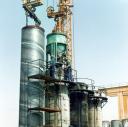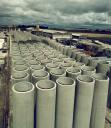Reinforced concrete
For this type of pipe, the manufacturing process consists of the following stages:
- Steel cylinder manufacturing.
- Nozzle formation and expansion.
- Creation of reinforcement cage.
- Vertically-cast pipe concreting.
- Pipe curing.
Steel cylinder manufacturing
Cylinders are made up of a cylinder of steel plate lap welded in a spiral by an automatic machine, it does this from coils of metal steel with a width equal to or greater than one metre. The corresponding male/female “nozzles” are welded to the ends, guaranteeing their dimensional tolerances.
Once the cylinders have been formed, they are placed on a turning gear and the nozzle pieces are coupled to the ends. These nozzle ends are pre-tested by cross-welding with penetrating fluids and clamped around the outside of the cylinder. Inspection of their dimensions is mandatory.
After the cross welding of the joint between heads has been made, each cylinder is subjected to hydraulic internal pressure testing in a horizontal press.
Nozzle formation and expansion
Depending on the requirements of each project, the ends of steel cylinders may be fitted with nozzle pieces, made up of:
- A rolled profile for the rubber seal.
- A plate for the welded joint.
Flat plates of suitable size to form the nozzles are curved and the ends are welded together. Then they are expanded in a purpose-built hydraulic press to achieve perfect dimensional control.
If the heads are to be fitted with an elastic joint, the material for the joint is first shot-peened and once formed geometrically, it is given a coat of primer protection and is fitted onto the pipe. Then it is coated with epoxy alimentary resin to guarantee its durability against any aggressive agent.
Creation of the reinforcement cage
The steel used in fittings (axis rods and separators) is smooth, whereas the coils of reinforcement are made from corrugated steel.
To make the axis rods, a coil of smooth steel of the chosen diameter is fitted onto the winder. The steel runs through straightening rollers to a pre-set position when it is automatically sheared.
To make the reinforcement cages, a coil of corrugated steel of the chosen diameter is fitted onto the reinforcement cage winder. Once the axis rods are fitted in the housings on the machine plates, they start turning and one of them moves longitudinally along the spiral while the other remains in a fixed vertical plane. As they rotate, the plates roll the corrugated steel over the axis rods, producing a weld point at each intersection of the spiral with the axis.
Vertically-cast pipe concreting
If the core is not pre-fabricated by radial compression, an inner mould is used to concrete it, in which the process is as follows:
- Fit the inner mould onto the bottom centring plate.
- Fit the steel cylinder onto the bottom centring plate
- Fit the outer reinforcement.
- Fit the outer mould.
- Fit the upper centring plate.
- Fit the concrete packer.
Moulds are opened and closed by means of a hydraulic system that ensures absolute tightness.
After that, the concrete is poured in until the mould is completely full. During concreting, the unit is vibrated by means of vibrators fitted in the mould to ensure the absence of pores and proper distribution of the concrete.
The pipe will remain in the mould until it has reached pre-set minimum strength. Curing can be either natural or accelerated.
When the minimum strength has been reached, the mould is removed and the pipe is transferred to the curing and storage area.
Pipe curing
The tube is lifted using appropriate collar clamps and stood vertically, either directly on the floor or on a suitably levelled bench of planks. A sprinkler device is then fitted to the top of the pipe to keep the surfaces moist until it is shipped to the work site.
In the event that the outer surface of the pipe needs to be given extra protection, it is painted with epoxy pitch. This process is done in the shop once the pipe has reached the anticipated degree of curing and before being shipped to the work site.


























